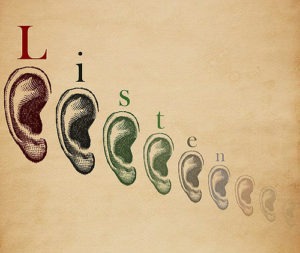
Reading Time: 4 minutes
Put on your listening ears. Perhaps you’ve said something similar to your kids. Or, maybe you’ve heard it directly.
In our everyday life, it’s increasingly more difficult to communicate, despite, or perhaps because of the surge in digital and social options. At the epicenter of this communication fatigue is advertising.
But instead of addressing the cause, the marketing industry often band-aids the symptoms. With blinders on, the space-race has become a mission to be heard. To reach more “eyes” and “ears,” we seek the trending platform and climb aboard to hurl our message. We think if we yell loud enough then we’ll win business.
 How effective is this tactic when your children do it? Over time, their verbal bombardment becomes ineffective, just like many of your ads that are ignored or systematically thwarted through ad-blockers. We teach our kids not to interrupt yet many campaigns are built on disruption. There are too many companies trying to differentiate simply by broadcasting as often as they can afford. But are they saying anything that matters to the recipients?
How effective is this tactic when your children do it? Over time, their verbal bombardment becomes ineffective, just like many of your ads that are ignored or systematically thwarted through ad-blockers. We teach our kids not to interrupt yet many campaigns are built on disruption. There are too many companies trying to differentiate simply by broadcasting as often as they can afford. But are they saying anything that matters to the recipients?
1. Become a master listener
Flip this dynamic and start listening. If it doesn’t sound glamorous, you’re right. It requires patience.
It may require you to resist the urge, or pressure, to charge out of the gate with a flashy ad campaign. Clients certainly like seeing their brand plastered everywhere. But they won’t be smiling for long if that pricey ad spend doesn’t yield results. Your communications will have little impact if no one cares.
2. Listen, to be heard
Listening builds rapport. It shows that you are interested and validates those that are expressing their beliefs and preferences. It’s the foundation of a two-way conversation. When you reflect their voice in your messaging, the audience feels heard, and trust is established. Now, you have their ear.
Sounds like common sense, but are you doing it? If you truly know what moves your constituents to action then bravo. But, if you can’t, no shame, only improvement to be had.
3. Gather intelligence
 Becoming a master listener requires humility. But it’s not passive. By listening, you discover:
Becoming a master listener requires humility. But it’s not passive. By listening, you discover:
- who are your clients and prospects
- how they think
- what they care about, value and need
- their preferred communication style and platforms
- what common problems they share
- and, ultimately, how they make decisions
This process can even help you uncover your company’s core value. You’d be surprised how many businesses haven’t thought about this.
If this is new to you, I recommend you dig into consumer research before you run another ad. This data will inform your strategy and determine the demographics and psychographics of the segments that will most likely find value in your offerings. Then, you’ll be in a far stronger position to have a meaningful conversation with them.
4. Master the basics
 The next time you are at a next meeting, do something radical – silence your phone – and listen. You’ll be amazed how much more valued and satisfied your colleagues will feel by your undivided attention. And, don’t be surprised when they start inquiring about and supporting your ideas. Strong relationships are built on reciprocity.
The next time you are at a next meeting, do something radical – silence your phone – and listen. You’ll be amazed how much more valued and satisfied your colleagues will feel by your undivided attention. And, don’t be surprised when they start inquiring about and supporting your ideas. Strong relationships are built on reciprocity.
5. Reseach tools
For your company, you’ll want to conduct qualitative and quantitative research. Sounds expensive, perhaps. But it doesn’t have to be. While there can be many levels of exploration, start with what you can access for free or with minimal resources. Look at your company’s and competitors’ pages. What are common pain points? Note what content prompts a like, comment, or share.
Use the keyword tool to research what and how people are searching. While you’ll need an Adwords account you don’t have to spend a dime. These phrases can then be integrated into your content, creating relevance and elevating your search rank.
Dig in or install it if you haven’t yet. Data, like where visitors are coming from, can teach you where to be listening. Gain insights, like which pages they most often visit, how long they spend there and what they click on.
- Reputation
Your company has most likely been reviewed on sites like Yelp, Google and Facebook. The research here is two-fold.
First, what are they saying? Take a deep breath and listen. Some will be over-the-moon while others may be quite negative. Regardless, make sure to reply to all reviews in a courteous tone and solve any concerns.
 Second, understand how influential reviews are in the buying cycle. Google has coined online consumer research at the point of sale as the zero moment of truth (ZMOT). We’ve all seen it and most have done it, you are looking at a product in a store or online and you pull out your phone to check reviews, prices and comparison shop. As these platforms continue to influence more people, encourage your customers to review your business.
Second, understand how influential reviews are in the buying cycle. Google has coined online consumer research at the point of sale as the zero moment of truth (ZMOT). We’ve all seen it and most have done it, you are looking at a product in a store or online and you pull out your phone to check reviews, prices and comparison shop. As these platforms continue to influence more people, encourage your customers to review your business.
- Brick and mortar.
If you have a store-front, talk with the clientele. It doesn’t have to be a formal focus group or interview. You can keep it casual. Why do they shop there? What are their barriers to purchase? You’ll start to see trends. And don’t forget to observe. Are they looking at price tags and then putting it back on the shelf?
6. Cue strategy
 Now you are ready to thread this knowledge into every touch-point along the consumer path to purchase, whether this is through web copy, ads, that new social platform you are itching to try, or, how your team answers the phone and email. By having listened, you able to offer content, products, and services to audiences for which it’s relevant.
Now you are ready to thread this knowledge into every touch-point along the consumer path to purchase, whether this is through web copy, ads, that new social platform you are itching to try, or, how your team answers the phone and email. By having listened, you able to offer content, products, and services to audiences for which it’s relevant.
You’ll be able to more accurately offer a solution instead of generically pushing a product. After all, no one likes to be pestered into buying something. Those seeking a quick transaction can lead to buyers remorse, which of course doesn’t serve your brand in the long run.
Take it further and provide information that answers questions you now know they have or offer a free trial, sample or initial consult that generate solid leads. “Prospects” will feel less like dollar signs and more respected. You’ll move from selling to fan-building.
So, the next time you want to push an outbound campaign, press pause. Remember, it’s not about you, it’s about the customer. Listen to them. In our hyper-competitive marketplace, this may well be what drives them to change buying decisions and chose you.
